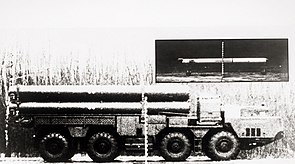SS-N-21 Sampson
| SS-N-21 Sampson | |
|---|---|
| General Information | |
| Type | Cruise missiles |
| Local name | 3K10, S-10 garnet, 3M10 |
| NATO designation | SS-N-21 Sampson |
| Country of origin |
|
| Manufacturer | Nowator NPO |
| development | 1971 |
| Commissioning | 1987 |
| Working time | in service |
| Technical specifications | |
| length | 6.20 m (with booster) |
| diameter | 518 mm |
| Combat weight | 1485 kg (without booster) |
| span | 3300 mm |
| Drive First stage Second stage |
Solid fuel booster RD-95-TM300 Turbofan |
| speed | Mach 0.7 |
| Range | 2400-2900 km |
| Furnishing | |
| steering | Inertial navigation platform |
| Target location | TERCOM |
| Warhead | Nuclear warhead 200 kt or 200–382 kg fragmentation warhead |
| Weapon platforms | Submarines |
| Lists on the subject | |
The SS-N-21 Sampson ( S-10 "Granat" ) is a Soviet submarine-based cruise missile . The GRAU index is 3K10 .
development
The development of the S-10 Granat began in 1971 in the Nowator NPO design office . The first test launch took place on September 21, 1978 in the Barents Sea . The first test launch from a submerged submarine took place on July 21, 1982. In April 1984 the first weapons were delivered to the Soviet Navy. In 1987 the S-10 Granat system was finally ready for use.
technology
The S-10 grenades are stored in sealed protective containers in the torpedo room of the submarine. For takeoff, the protective container with the cruise missile is pushed into a 533 mm standard torpedo tube. S-10 Granat can be launched from a depth of 40 m. After leaving the torpedo tube, the rocket booster ignites and drives the missile encapsulated in the protective container to the surface of the water. After piercing the surface of the water, the booster of the cruise missile ignites and drives it out of the protective container. Then the wings unfold and the turbofan engine is started. The cruise flight takes place at an altitude of 50 to 200 m. A radar altimeter ensures the necessary safety distance between the missile and the terrain. The navigation during the cruise is carried out by means of an inertial navigation platform . A terrain contour comparison system (TERCOM) is used for approaching the target , which compares the terrain overflown with stored data. In the first execution, a precision ( CEP ) of around 150 meters was achieved. With the new versions, the precision should be between 10 and 45 meters thanks to an additional GLONASS navigation system . Originally the S-10 Granat was equipped with a nuclear warhead with an explosive power of 200 kt . Newer versions are said to be equipped with a conventional fragmentation warhead.
The SS-N-21 can penetrate deep into enemy territory and destroy airfields, bunkers , radar systems or command posts, as well as infrastructure. US and NATO experts see the SS-N-21 as an excellent second strike weapon , but can also be used for a successful first strike .
variants
SS-N-21 Sampson : stationed on submarines
- S-10 Granat (GRAY: 3K10): Standard version with 200 kt nuclear warhead . Range 2400-2900 km.
SS-C-4 Slingshot : land-based version
- RK-55 Relief (GRAY: 3K12): Installed on a MAZ-543 M-8 × 8 truck (alternatively: MAZ-7310) (6 guided missiles). Development stopped. Range 2600-2900 km.
status
At the START II disarmament negotiations in 1993, Russia declared 240 submarine-based S-10 grenade systems with nuclear warheads. Of these, 200 were later converted. They got an improved navigation system and were equipped with conventional fragmentation warheads. The vehicle-bound version RK-55 Relief was initially stationed with six carrier vehicles and around 84 rockets in Jelgava in the Latvian Socialist Soviet Republic or was under construction. Separated in the course of the INF contract in 1987. The last of the 84 remaining RK-55 missiles was scrapped in October 1988.
The SS-N-21 can be stationed on the following classes of submarines:
- Project 971 ( NATO code name : Akula)
- Project 671RTM (Victor-III)
- Project 945 (Sierra)
- Project_885 (Graney)
- Project_955 (Borei)
- Project 667AT (Gruscha) (40 guided missiles in vertical launch tubes)
Web links
Individual evidence
- ↑ Strategic Missile Complex 3K10 "grenade". In: bastion-karpenko.ru. НЕВСКИЙ БАСТИОН, accessed December 4, 2019 (Russian).
- ↑ a b RK-55 relief (SS-N-21 Sampson). In: missiledefenseadvocacy.org. Missile Defense Advocacy Alliance, accessed October 1, 2018 .
- ↑ SS-N-21 “Sampson” (RK-55). In: missilethreat.csis.org. Center for Strategic and International, accessed October 1, 2018 .
- ↑ a b militaryrussia.ru , accessed January 17, 2013 (Russian)
- ↑ https://www.bits.de/NRANEU/BMD/documents/infmou.htm
